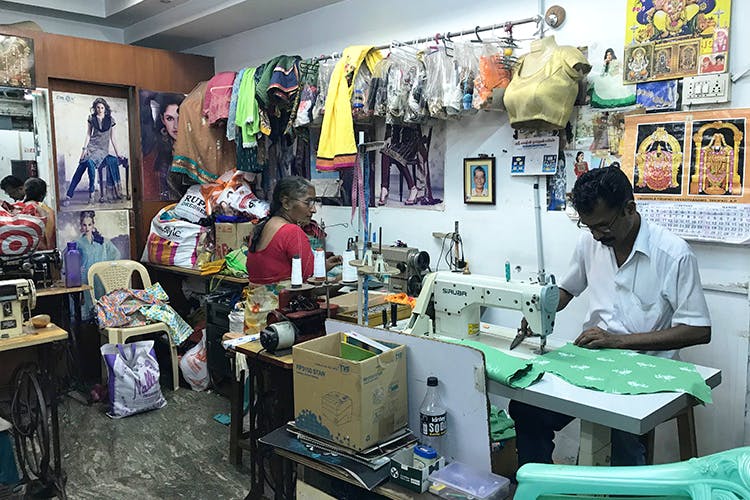Recognizing the Tailoring Process: From Material Choice to Final Fitting for the Perfect Wardrobe
The customizing procedure is a complicated interaction of art and science, starting with the crucial choice of fabric choice and finishing in the accurate modifications of last fittings. Each textile type brings special high qualities that affect not just the visual allure however likewise the garment's long life and viability for numerous occasions.
Significance of Textile Selection
Choosing the ideal fabric is crucial in the tailoring procedure, as it directly influences the convenience, longevity, and overall visual of the last garment (tailor perth). The choice of fabric establishes the foundation for the garment's capability, style, and efficiency. Different textiles possess unique residential or commercial properties, such as stretch, breathability, and weight, which can significantly affect how the garment drapes and fits the body
Moreover, material choice affects the garment's long life and convenience of treatment. Top quality textiles can endure wear and tear, preserving their look and framework with time, while lower-quality materials might lead to pilling or fading. In addition, the appropriate textile adds to the garment's capacity to transition across celebrations and periods, thus enhancing adaptability.
A tailored item made from a proper material not only showcases workmanship however also raises the wearer's confidence. Comprehending the nuances of material choice is critical for any type of customizing venture. It ensures that the end product not only fulfills the visual needs of the customer however additionally straightens with practical needs, thereby accomplishing an unified balance between form and feature in the tailored wardrobe.
Kinds of Fabrics and Their Usages
Comprehending the different kinds of fabrics readily available is crucial for making educated choices during the customizing procedure. Each fabric has unique features that determine its suitability for particular garments and events.
Cotton, recognized for its breathability and gentleness, is suitable for laid-back wear and summer clothes. Its adaptability permits it to be customized into everything from t shirts to gowns. Wool, on the various other hand, is favored for its heat and structure, making it a superb option for formal suits and outerwear - tailor perth. Its natural flexibility aids garments maintain shape over time.
Silk radiates deluxe and is lightweight, making it ideal for eveningwear and delicate blouses; nevertheless, it calls for cautious handling because of its frailty. Bed linen, with its distinctive coating, is a preferred choice for cozy environments, offering a airy and crisp feel, but it wrinkles quickly, which might impact the garment's appearance.
Artificial materials, such as polyester and nylon, offer sturdiness and resistance to wrinkles, making them ideal for day-to-day wear and energetic clothes. Comprehending these material types and their properties enables for far better decision-making, making sure that each tailored item not only fits well however additionally lines up with the desired objective and occasion.
The Tailoring Strategies Explained
The art of tailoring depends on a variety of strategies that change textile into well-fitted garments. Central to this process is pattern preparing, where a tailor develops templates based upon the client's measurements and desired design. This initial action guarantees that the garment will certainly fit the wearer properly before any type of reducing takes place.
Once patterns are developed, reducing strategies enter play. Accuracy is vital as mistakes can result in misfitting garments. Tailors frequently make use of various reducing techniques, such as single-layer reducing for detailed styles and multiple-layer cutting for efficiency on standard patterns.
Basting is one more crucial method, allowing dressmakers to briefly stitch textile pieces together for an initial installation. This technique supplies the possibility to examine the drape and general shape prior to final stitching.
Seaming techniques, including flat-felled joints and French joints, boost the garment's longevity and visual appeal. Tailors also utilize techniques such as interfacing and padding to supply structure and shape to certain areas, like shoulders and collars.
Last but not least, ending up techniques, consisting of hemming and edge finishing, make certain the garment's long life while giving a sleek appearance. Together, these strategies create the backbone of effective tailoring, resulting in beautiful, custom-fit apparel.
Suitable Modifications and Factors To Consider

Key factors to Learn More Here consider consist of the shoulder fit, which needs to neither sag nor restrict activity, and the sleeve size, which should enable comfy arm activity while preserving a sleek look. In addition, adjustments at the waist can refine the silhouette, with alternatives to allow out or take in fabric as required.
The surge of trousers is one more vital variable; it ought to sit conveniently over the hips without triggering discomfort, allowing for simplicity of activity. Hemming sizes for both pants and skirts ought to show the wearer's preferred design while respecting percentages.

Keeping Your Tailored Clothes
Correct upkeep of tailored garments is necessary to protecting their fit and appearance with time. To make sure longevity, regular cleaning is critical. Always adhere to the care tag guidelines, which may suggest completely dry cleaning for fragile materials or device washing for even more resilient products. Avoid constant laundering, as this can use down the textile and modify the garment's shape.
Storage is just as vital; usage cushioned wall mounts for jackets and layers to maintain shoulder framework, and shop trousers folded up nicely or hung to stop creasing. Protect garments from straight sunshine, which can discolor shades and damage fibers.
In addition, periodic evaluations for small repair services can stop larger concerns. Inspect for loose buttons, fraying seams, or signs of moth damage, dealing with these problems immediately to maintain the garment's honesty.
Last but not least, consider seasonal rotation. Wearing tailored pieces in moderation permits textiles to recover, extending their lifespan. By executing these upkeep techniques, you can make certain that your customized find more info garments stay as beautiful as the day you initially wore them, boosting your perfect closet for several years ahead.
Conclusion
The customizing process, incorporating textile choice, competent methods, and specific fitting adjustments, plays a critical duty in producing garments that improve both comfort and style. Recognizing the relevance of maintenance expands the life of customized garments, solidifying their value in a well-curated wardrobe.
Selecting the best fabric is vital in the customizing process, as it directly influences the comfort, resilience, and general aesthetic of the last garment. The choice of material sets the foundation for the garment's efficiency, style, and performance. Various materials possess unique properties, such as stretch, breathability, and weight, which can dramatically affect exactly how the garment drapes and fits the body.
The art of tailoring counts on a selection of techniques that transform fabric into well-fitted garments.The tailoring process, including textile choice, experienced strategies, and precise fitting modifications, you can look here plays a critical function in creating garments that boost both convenience and design.